When a piece of expensive, gorgeous jewelry is for the fantastic presentation of yourself, the jewelry material is even more critical, as this is directly related to the comfort and style of the person who wears it. To ensure the proper healing and presentation of elegance, there are a variety of materials that you can give shots.
In this article, we will share some unique insights on materials ranging from long-lasting surgical steel to popular gold alloys so that you can choose the most suitable one for yourself! So, let’s get into it now!
1. Surgical Steel
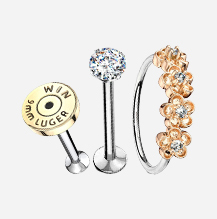
Despite some limitations, Surgical Steel has been a go-to choice for a long time when it comes to body piercing jewelry material. These surgical steel ornaments are durable and good for regular use. The price range is wide, which helps the users choose the one according to their budget. Let’s see the positive and negative sides of this material.
Pros
- Durability: No matter how long you use it, surgical steel doesn’t lose its smoothness quickly.
- Hypoallergenic: Surgical steel ingredients usually help protect the body from allergies.
- Cost-effective: Compared to other materials, the price is much more reasonable for surgical steel-made body jewelry.
- Variety: Available in various shapes and styles to suit your preferences.
- Easy Sterilization: Ensures safe piercing practices through effective sterilization.
Cons
- Not Completely Hypoallergenic: Some individuals with metal sensitivities may still experience reactions.
2. Titanium
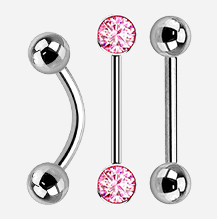
Those with allergy problems can choose titanium for their piercing, as it is remarkably compatible with different skin types. Besides, the lightweight nature is another reason many people like this material for their first piercing jewelry.
Pros
- Lightweight: Compared to others, the titanium helps to lessen the irritation in newly pierced areas.
- Biocompatible: Highly unlikely to cause allergic reactions, making it ideal for sensitive skin.
- Hypoallergenic: Helps to reduce irritation, especially for metal allergy patients.
- Durable: An excellent choice for regular use because of the strength of the material.
- Polished Finish: Its smooth surface makes cleaning and returning the initial look easier.
Cons
- Cost: More expensive than surgical steel, making it a less economical choice.
- Limited Color Options: Fewer choices compared to other materials.
3. Gold
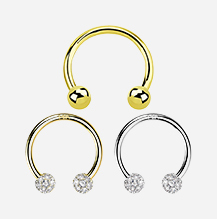
Gold is a widely used material for body piercing jewelry options around the globe. The elegant look that Gold can give is why so many people like it. However, using this material for piercing has both pros and cons.
Pros
- Luxurious Look: Gold ornaments usually give a luxury look.
- Durable: Gold is one of the most durable metals and, therefore, doesn’t get tarnished easily.
- Polished Finish: Provides a smooth surface for comfortable wear and easy cleaning.
- Good for Investment: The price of gold usually increases over time, and therefore, many prefer this as an investment!
Cons
- Expensive: Gold is the priciest option, as it is a premium material.
- Not Ideal for Initial Piercings: The alloys in gold jewelry may not be suitable for new body piercings.
4. Bioplast (Implant Grade)
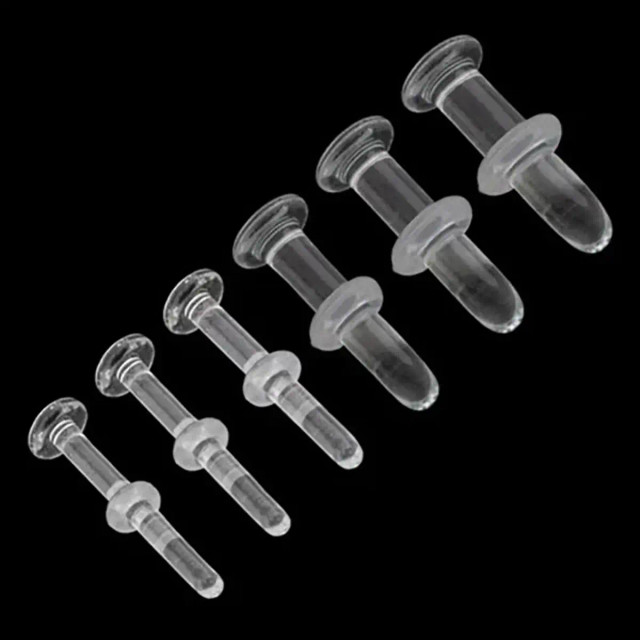
Well, this one was developed mainly for medical purposes. The Implant grade is, therefore, a good choice for you as it won’t harm your skin.
Pros
- Smart Adaptation: It quickly Adapts to the body and reduces irritation.
- Hypoallergenic: Those who are prone to allergy choose it since the ingredients used here help to protect from allergy issues.
- Quick Healing: Because of the ingredients, it usually accelerates the healing after piercing.
- Comfortable and Lightweight: Barely noticeable when worn.
- Transparent or Clear: Offers a subtle appearance, which can be very appealing for certain piercings.
Cons
- Less Durable: Not as robust as metal, making it more prone to tearing or breaking.
- Special Sterilization: The sterilization becomes difficult for bioplasts, considering the critical medical issues related to this material.
5. Glass
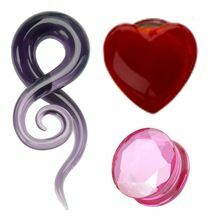
Glass is a fine option when you are looking for jewelry in the initial stage for your piercing. The material effectively gives the user an elegant appearance. Additionally, the borosilicate glass can absorb heat, so it is also preferable to first-timers!
Pros
- Non-allergic: It usually reduces the allergic reactions.
- Easy Cleaning: The surface is smooth and therefore, it’s easy to maintain.
- Variety of Styles: Available in various colors, patterns, and textures for a personalized look.
- Comfortable and Lightweight: Won't add bulk to your piercing.
Cons
- Fragile: May break or chip if dropped or subjected to impact.
- Best for Healed Piercings: Initial piercings are not recommended due to the risk of breakage and discomfort during the healing process.
- Limited Size Options: Not all sizes may be available due to their delicate nature.
6. Organic Substances (Horn, Bone, Wood)

Organic materials are gaining popularity as a piercing material nowadays as they do have significant health benefits. Besides, the variety is huge, as clays, woods, leaves, and many other natural materials are used for making these ornaments. At present, we can see many creative designs that prove the acceptance of this by people from different corners of the world.
Pros
- Natural and Lightweight: Easy to wear and offer a distinctive, organic look.
- Culturally Significant: Connect the wearer to traditions of body decoration.
- Variety of Hues and Textures: Provide a unique aesthetic with their natural variations.
Cons
- Porous Nature: If not correctly cared for, they can harbor bacteria, increasing the risk of infection.
- Difficult Maintenance: Because of the natural ingredients, the cleaning sometimes becomes difficult for the users.
7. Gold-toned Alloy

These are not pure gold but a mixed metal to ease daily use. While the jewelry looks very attractive, the price is not that high compared with pure gold.
Pros
- Appealing and Affordable: Offers a beautiful shine at an economical cost.
- Widely Available: Easily found in various designs and styles.
- Can Be Polished: Regular polishing can restore its luster.
Cons
- Unsuitable for New Piercings: Can oxidize (tarnish) and irritate piercings during the healing period.
- Allergic Reactions: The copper content may cause allergies in some individuals.
- Requires Maintenance: Regular cleaning and polishing are required to maintain its appearance.
Conclusion
The choice is yours! We have covered all the possible piercing materials that you may opt for. We highly recommend going for Surgical Steel, Titanium, or Gold as they are more protective against allergies and affordable as well. Additionally, you can have a wide variety of jewelry options with these materials to simplify the choice.
Now, it’s your turn to select the one based on our recommendations and your preferences. However, if you are still confused, we suggest you consult an expert piercer to choose the one based on your skin type and budget.
 Free Returns on all orders.
Free Returns on all orders. 










